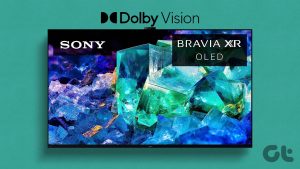Streaming platforms have replaced entertainment at home and everywhere. You may not longer have to visit a theatre for movies and watch your favorite TV shows. Inside these modern streaming apps like Netflix, Prime Video, Hulu, HBO Max, etc., you’ll find HDR (High Dynamic Range) and Dolby Vision labels to leave you wondering what they are and how they work.
HDR10 and Dolby Vision are video formats that take your video streaming experience to the next level. But some users still need help with these terms on their streaming devices. So, we are here to explain the difference between HDR10 and Dolby Vision.
What Is HDR
Nowadays, almost every 4K television offers HDR capabilities to enjoy the content at home. So let’s first understand HDR and how it improves your viewing experience. Every TV has a particular Dynamic Range, the difference between the brightest and the darkest parts of an image displayed on your TV screen. Dynamic Range is equivalent to the Display Contrast of your TV. But the older TVs cannot display better contrast levels due to bandwidth limitations.
HDR helps improve the contrast levels that give you deeper blacks and brighter whites. For example, if you have an OLED TV with HDR, you can see improved picture quality with better contrast levels, sharpness, more detail in dark areas or shadows, and a brighter picture. Also, you don’t necessarily need a 4K TV to enjoy HDR. If you want a TV with a screen size less than 50 inches, you can easily get away with a Full HD TV with HDR to enjoy the same enhanced contrast and color gamut.
So if you are watching a film with too many scenes in dark environments or sunsets, HDR will help improve the brightness levels to the extent that you don’t miss any detail while watching those scenes. Modern OLED (Organic Light Emitting Diodes) TVs offer better contrast levels and control brightness for every pixel displayed on the screen compared to LCD TVs.
The HDR video format is divided into two major formats that are available for TVs – HDR10 and Dolby Vision.
What Is HDR10
Introduced in August 2015, HDR10 is a format advocated by the UHD Alliance, which comprises consumer electronics manufacturers, film and TV studios, streaming platforms, and technology companies. The UHD Alliance has set minimum key requirements for TVs to be qualified for displaying content in HDR10 format. Starting in 2016, every product that claims to support HDR10 needs to be UHD Alliance Certified. There’s a 10 after HDR because this format supports 10-bit color depth, which is approximately 1024 shades of primary colors – Red, Green, and Blue.
TVs that have HDR10 use Static Metadata while projecting visuals on the screen. That means the luminance and color values remain the same for every frame from start to finish. But since this format doesn’t require any licensing fee, many TV manufacturers will include this in their product features. Unfortunately, HDR10 is not backward compatible with the SDR.
What Is Dolby Vision
Dolby Vision is a format developed by Dolby Labs, Inc. in 2014, and it requires TV makers to pay a licensing fee to Dolby for including this format. But another major difference between HDR10 and Dolby Vision is that Dolby Vision uses Dynamic Metadata. That means contrast levels, brightness, and colors are adjusted for each frame of the content you watch on your TV. Dolby Vision amplifies your viewing experience by preserving details for every scene, depending on how bright or dark it is.
Dolby works closely with TV manufacturers to set specific luminance and color levels values for the best possible output on your TV. But this also depends on how capable your TV displays Dolby Vision content in its truest format. Also, you’ll need a good internet connection to satisfy the bandwidth needs of streaming Dolby Vision content.
What Is HDR10+
Another HDR format that is being made popular by manufacturers like Samsung is HDR10+. Like Dolby Vision, HDR10+ also supports Dynamic Metadata but has better brightness levels than HDR. The HDR10+ format is also backward compatible, letting you watch content in older HDR formats on your new TV.
Devices like the 3rd gen Apple TV 4K support HDR10+ for Samsung TVs that cannot stream in Dolby Vision. You can also find shows like The Boys and The Rings of Power on Amazon Prime Video, supporting HDR10+ streaming. Do note that in the case of UltraHD BluRays with Dolby Vision, the content will be played in HDR10 if your TV supports only HDR10+.
Which Is The Best
This depends on what fits your budget when buying a new TV. While the HDR content tagged with HDR10 and Dolby Vision is available on almost all streaming services. However, the HDR10+ is available for Apple TV+ app, Amazon Prime Video, and newer Blu-ray Discs. If you want the most high-end experience, go for an OLED TV from LG or Sony and an internet connection with 100MBps speed for streaming content.
But clearly, Dolby Vision is superior in handling the dynamic range and color levels due to its usage of Dynamic Metadata. You can check out our recommendations for the best budget TVs under $1000.
Last updated on 18 January, 2023
The above article may contain affiliate links which help support Guiding Tech. However, it does not affect our editorial integrity. The content remains unbiased and authentic.














